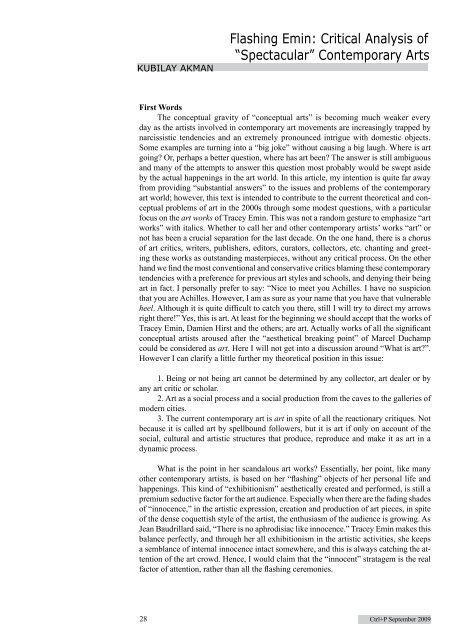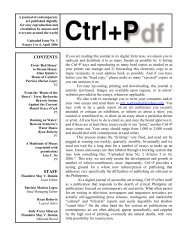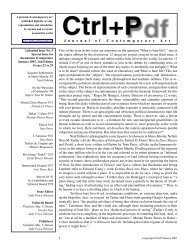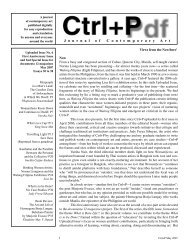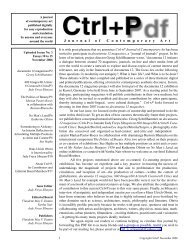Issue 15 - Pdf Ctrl+P - CTRL+P: a journal of contemporary art
Issue 15 - Pdf Ctrl+P - CTRL+P: a journal of contemporary art
Issue 15 - Pdf Ctrl+P - CTRL+P: a journal of contemporary art
You also want an ePaper? Increase the reach of your titles
YUMPU automatically turns print PDFs into web optimized ePapers that Google loves.
kubilay akman<br />
Flashing Emin: Critical Analysis <strong>of</strong><br />
“Spectacular” Contemporary Arts<br />
First Words<br />
The conceptual gravity <strong>of</strong> “conceptual <strong>art</strong>s” is becoming much weaker every<br />
day as the <strong>art</strong>ists involved in <strong>contemporary</strong> <strong>art</strong> movements are increasingly trapped by<br />
narcissistic tendencies and an extremely pronounced intrigue with domestic objects.<br />
Some examples are turning into a “big joke” without causing a big laugh. Where is <strong>art</strong><br />
going? Or, perhaps a better question, where has <strong>art</strong> been? The answer is still ambiguous<br />
and many <strong>of</strong> the attempts to answer this question most probably would be swept aside<br />
by the actual happenings in the <strong>art</strong> world. In this <strong>art</strong>icle, my intention is quite far away<br />
from providing “substantial answers” to the issues and problems <strong>of</strong> the <strong>contemporary</strong><br />
<strong>art</strong> world; however, this text is intended to contribute to the current theoretical and conceptual<br />
problems <strong>of</strong> <strong>art</strong> in the 2000s through some modest questions, with a p<strong>art</strong>icular<br />
focus on the <strong>art</strong> works <strong>of</strong> Tracey Emin. This was not a random gesture to emphasize “<strong>art</strong><br />
works” with italics. Whether to call her and other <strong>contemporary</strong> <strong>art</strong>ists’ works “<strong>art</strong>” or<br />
not has been a crucial separation for the last decade. On the one hand, there is a chorus<br />
<strong>of</strong> <strong>art</strong> critics, writers, publishers, editors, curators, collectors, etc. chanting and greeting<br />
these works as outstanding masterpieces, without any critical process. On the other<br />
hand we find the most conventional and conservative critics blaming these <strong>contemporary</strong><br />
tendencies with a preference for previous <strong>art</strong> styles and schools, and denying their being<br />
<strong>art</strong> in fact. I personally prefer to say: “Nice to meet you Achilles. I have no suspicion<br />
that you are Achilles. However, I am as sure as your name that you have that vulnerable<br />
heel. Although it is quite difficult to catch you there, still I will try to direct my arrows<br />
right there!” Yes, this is <strong>art</strong>. At least for the beginning we should accept that the works <strong>of</strong><br />
Tracey Emin, Damien Hirst and the others; are <strong>art</strong>. Actually works <strong>of</strong> all the significant<br />
conceptual <strong>art</strong>ists aroused after the “aesthetical breaking point” <strong>of</strong> Marcel Duchamp<br />
could be considered as <strong>art</strong>. Here I will not get into a discussion around “What is <strong>art</strong>?”.<br />
However I can clarify a little further my theoretical position in this issue:<br />
1. Being or not being <strong>art</strong> cannot be determined by any collector, <strong>art</strong> dealer or by<br />
any <strong>art</strong> critic or scholar.<br />
2. Art as a social process and a social production from the caves to the galleries <strong>of</strong><br />
modern cities.<br />
3. The current <strong>contemporary</strong> <strong>art</strong> is <strong>art</strong> in spite <strong>of</strong> all the reactionary critiques. Not<br />
because it is called <strong>art</strong> by spellbound followers, but it is <strong>art</strong> if only on account <strong>of</strong> the<br />
social, cultural and <strong>art</strong>istic structures that produce, reproduce and make it as <strong>art</strong> in a<br />
dynamic process.<br />
What is the point in her scandalous <strong>art</strong> works? Essentially, her point, like many<br />
other <strong>contemporary</strong> <strong>art</strong>ists, is based on her “flashing” objects <strong>of</strong> her personal life and<br />
happenings. This kind <strong>of</strong> “exhibitionism” aesthetically created and performed, is still a<br />
premium seductive factor for the <strong>art</strong> audience. Especially when there are the fading shades<br />
<strong>of</strong> “innocence,” in the <strong>art</strong>istic expression, creation and production <strong>of</strong> <strong>art</strong> pieces, in spite<br />
<strong>of</strong> the dense coquettish style <strong>of</strong> the <strong>art</strong>ist, the enthusiasm <strong>of</strong> the audience is growing. As<br />
Jean Baudrillard said, “There is no aphrodisiac like innocence.” Tracey Emin makes this<br />
balance perfectly, and through her all exhibitionism in the <strong>art</strong>istic activities, she keeps<br />
a semblance <strong>of</strong> internal innocence intact somewhere, and this is always catching the attention<br />
<strong>of</strong> the <strong>art</strong> crowd. Hence, I would claim that the “innocent” stratagem is the real<br />
factor <strong>of</strong> attention, rather than all the flashing ceremonies.<br />
28 <strong>Ctrl+P</strong> September 2009


